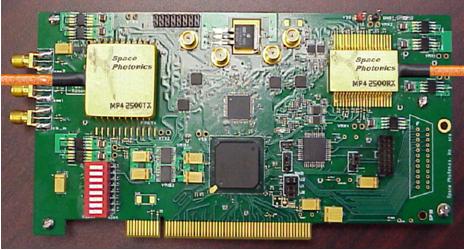
FAYETTEVILLE, Ark. — The University of Arkansas is creating a center to test the durability of high-tech, high-speed fiber-optic communication devices made for the extreme environments faced by military and space flight equipment, thanks to an award from a local company that makes the devices.
Space Photonics Inc. will award about $225,000 over two years to two researchers, Pat Parkerson in computer engineering and Rick Ulrich in chemical engineering, to assist in the establishment of the Arkansas Space and Photonics (ASaP) Optoelectronics Qualifications Center. The center will perform environmental, electrical and mechanical tests on high-speed fiber-optic communication devices created by Space Photonics Inc. for use in satellites, military aircraft and spacecraft.
|
Matt Leftwich, senior development specialist and lead engineer, Space Photonics Inc |
“We want to pre-screen our parts to gain a particular level of certainty as to how reliable the devices will be in any given environment,” Leftwich said.
|
Chuck Chalfant, president and C.E.O., Space Photonics Inc. |
“Chuck is keeping technically trained people in Arkansas,” Ulrich said.
Space Photonics Inc. specializes in the design, fabrication, and testing of free-space optical communication devices, multichannel, fiber-optic transmitters and receivers and other equipment with a total bandwidth of more than 10 gigabits per second, a speed anywhere from 100 to 2,000 times faster than cable modem or DSL, the current broadband communication devices with which most people are familiar. From another perspective, this would be the equivalent of moving all the information from a standard DVD in about five seconds.
Such speed is essential to high-risk space and military missions. High-speed fiber-optic telecommunication devices could, for instance, allow for better communication between shuttles and ground control and allow scientists to get massive amounts of information quickly sent from a Mars rover back to Earth. There are a slew of other spacecraft and military applications that do or eventually will require high-speed data communications.
Fiber-optic communication devices and interconnect materials also allow for a reduction in weight, size and power consumption when compared to current copper-based communication devices and interconnects.
“The bandwidth demands continue to increase. With new technology, such as high-resolution imaging devices, autonomous field assay devices, lab-on-a-chip technology, unmanned aerial vehicles, et cetera, you have a lot of data going back and forth," Leftwich said. SPI makes components that take in information in the form of photons, or light particles, and translate it into electronic data for interpretation by computers. The SPI devices offer an increase in speed of several hundred-fold over the current technology.
To test the devices, the researchers will use a vibration system that applies g-forces at various frequencies in multiple directions to test SPI’s devices under harsh vibration. If they fail, scientists at SPI can dice up the components and look at them using a scanning electron microscope to analyze what caused the failure. They will also take the components and expose them to extremes of hot and cold temperatures then examine them again. Next, they will use an oven-like environment to expose the device to different levels of humidity over a range of temperatures. The devices will be sent elsewhere for radiation testing, another essential component for pre-flight qualification for use of SPI’s devices in space and defense systems. Additional inspection steps, labeling and documentation procedures and commercial-off-the-shelf device-level testing will also be performed to ensure complete system compliance with environmental standards.
All of these tests mimic the conditions found in space -- radiation exposure, large and rapid changes in temperature or humidity, and g-force variations. To qualify for use in space, a component must be able to work under all of these less-than-ideal conditions.
“Basically, we give the component to Rick, and he tries to break it,” Parkerson said. “Then he gives it to me and I test it electrically. If it survives his torture and my testing, then it will be qualified,” based on a specific set of approved standards and testing protocols.
NASA and the Department of Defense require the highest standard for devices such as the ones that SPI makes for use in satellites or military technology.
“We have no room for error,” Ulrich said. “When we let it go, it has to be perfect.”
The funding will allow Ulrich and Parkerson to get essential equipment for the testing in addition to employing two graduate students to assist with the work. Both researchers credit Chalfant, a UA graduate, with building a high-tech company with a strong Arkansas base. Leftwich, currently a microelectronics-photonics doctoral student, the appointed ASaP Center director and a long-term associate of SPI, has aided Chalfant and SPI in the development of their packaging technology since the company was founded in 1998.
The center will seek to develop the ability to qualify technology at the highest level for space and defense contractors -- a process that will take about two years to establish. Although at first the researchers will concentrate on the SPI devices, the facility will be open to other people to use at reasonable rates.
“We want to attract outside companies and projects to Arkansas,” Parkerson said.
“It is a secondary goal of the ASaP Center to eventually be utilized, on a subcontracting basis, as an outside device pre-screening and qualifications source allowing the center to become self-sufficient and utilized by any and all that require the testing services that it will offer,” said Leftwich.
Contacts
Matt Leftwich, senior development specialist/lead engineer, Space Photonics Inc., (479) 575-3368, mleftwich@spacephotonics.com
URL: http://www.spacephotonics.com
Chuck Chalfant, president and CEO, Space Photonics Inc., (479) 575-5316, cchalfant@spacephotonics.com
J. Patrick Parkerson, associate professor, computer science computer systems engineering, (479) 575-6039, jpp@engr.uark.edu
Rick Ulrich, professor, chemical engineering, (479) 575-5645, rulrich@uark.edu
Melissa Lutz Blouin, science and research communications manager, Office of University Relations, (479) 575-5555, blouin@uark.edu

